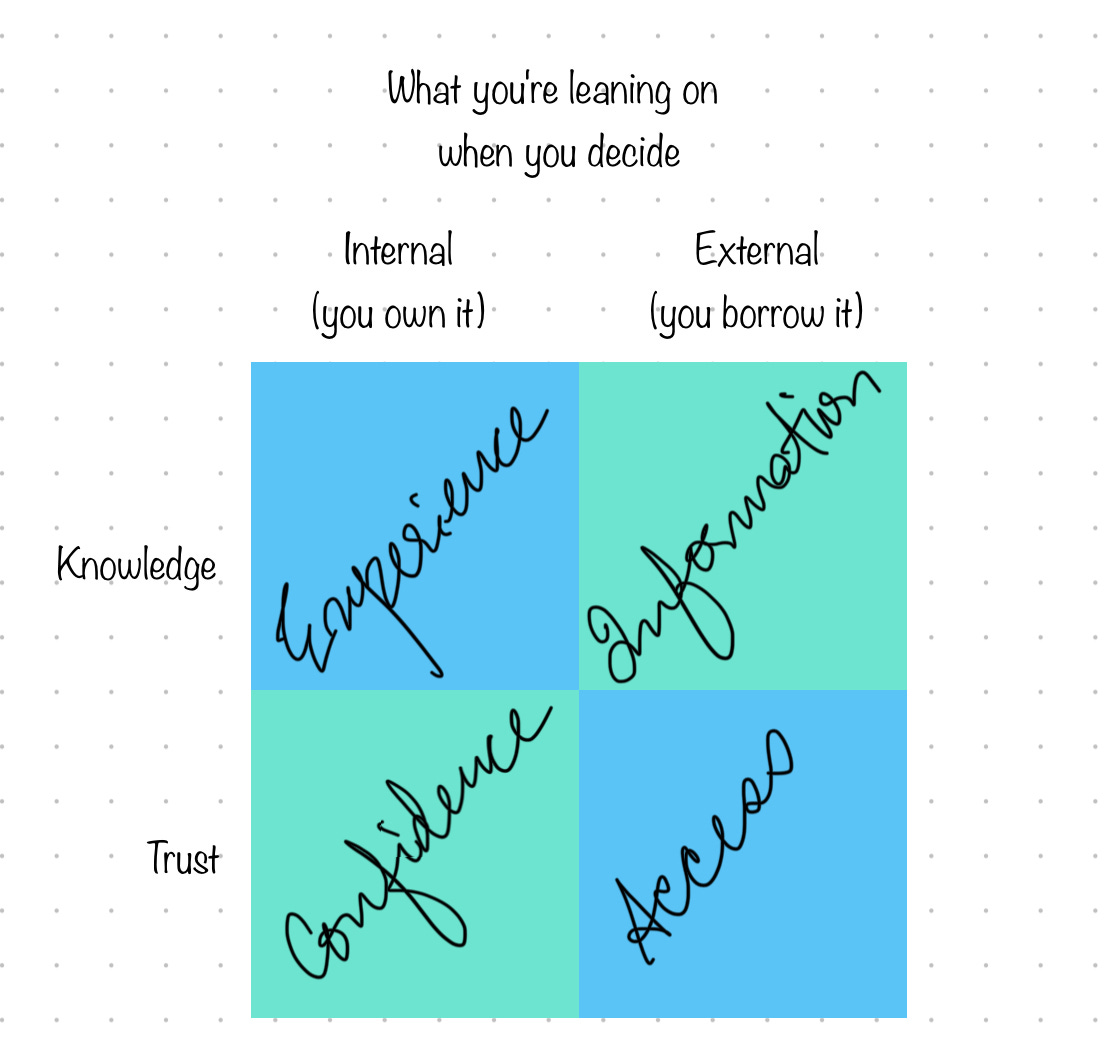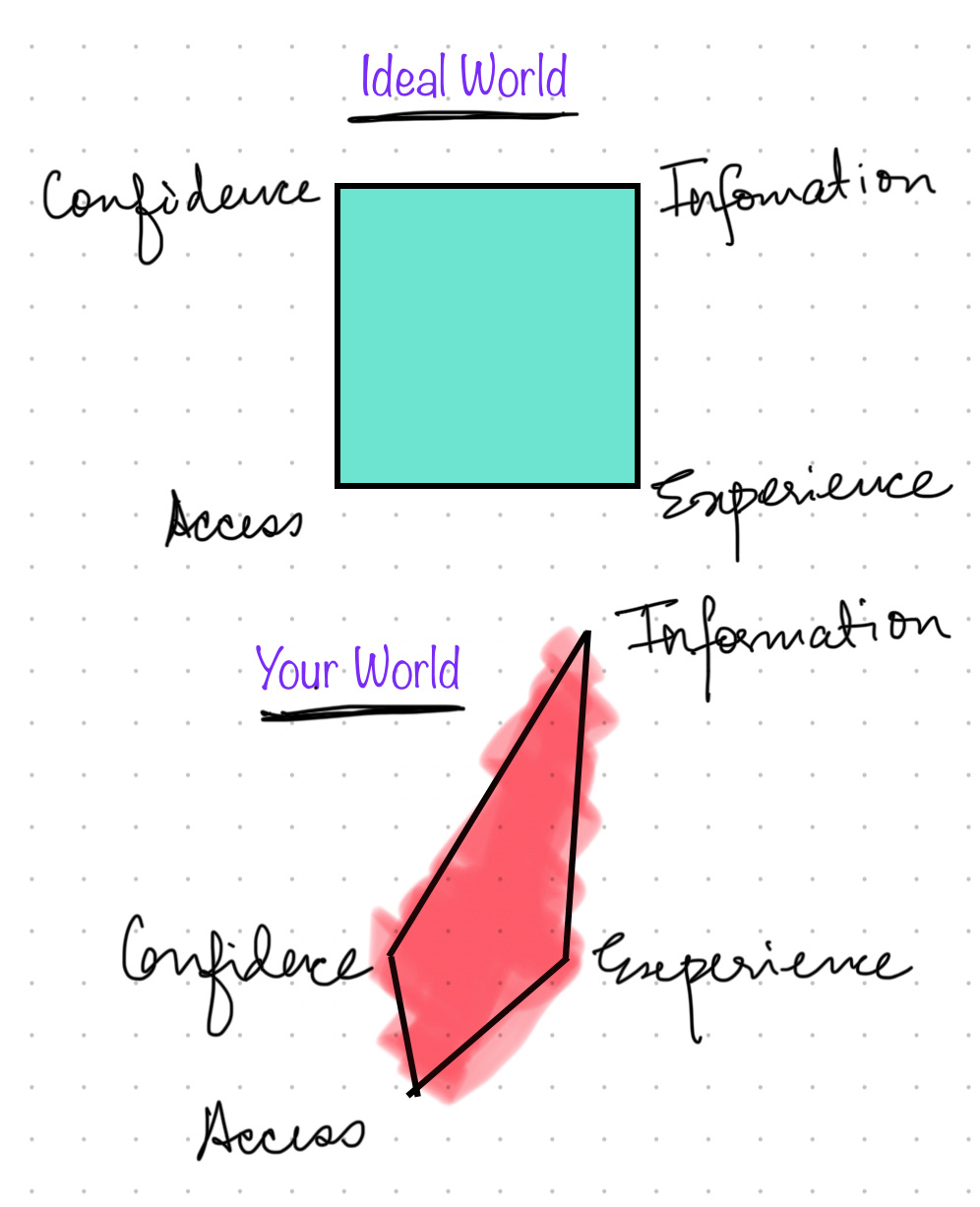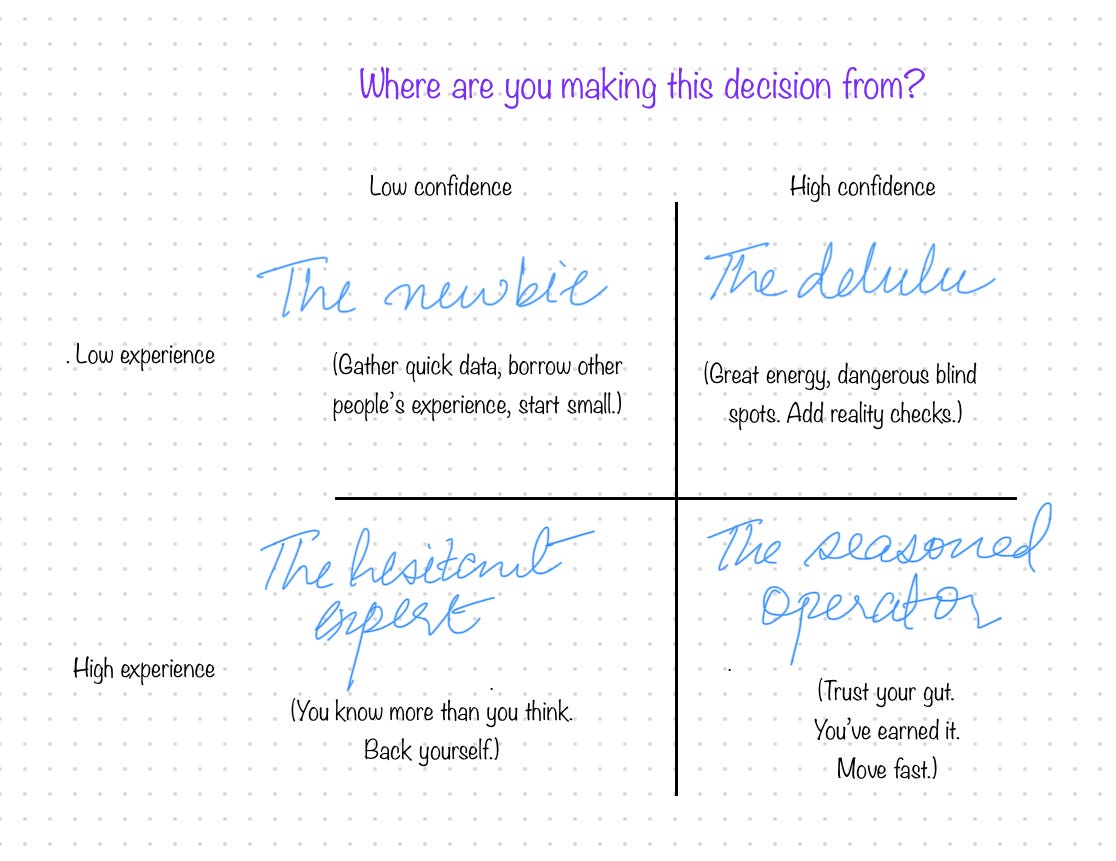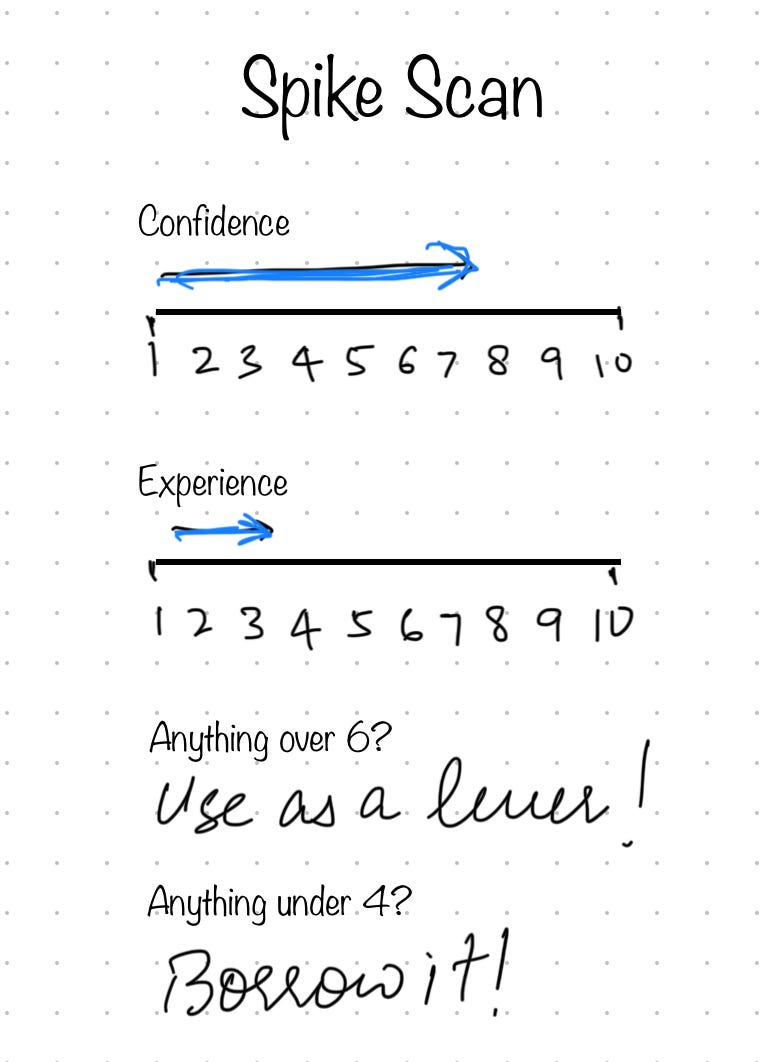Making Good Decisions with Limited Data
(Even When You’re Freaking Out)
You’ve been there.
Staring at a decision. Tabs open. Brain spiraling. That awful space between “I don’t want to mess this up” and “I wish someone would just tell me what to do.”
We’re told good decisions are logical. Data-backed. “Smart.” But in real life?
The data is late. The options aren’t clear. And the stakes feel high. So we stall. Or we default to the familiar. Or worse, we outsource our judgment.
Here’s the thing nobody tells you enough:
Great decisions aren’t built on perfect information.
They’re built on confident spikes.
When I think about what anchors a decision, especially in chaotic, blurry, high-stakes moments, it usually comes down to four things:
What do I know? (Information)
What have I done before? (Experience)
Who and what can I tap into? (Access)
Do I trust myself enough to decide? (Confidence)
Let’s call them decision spikes.
Now here’s where it gets interesting:
When you don’t have time, money, data, or all of the above, you don’t need all the spikes to be strong. You just need to lean hard on the ones that are.
And more often than not, the ones that move the needle fastest are confidence and experience.
Because they amplify everything else.
They give shaky information clarity.
They make imperfect access useful.
They reduce the fear of getting it “wrong.”
And they allow you to act.
This isn’t a productivity hack or a mental model for the fridge door. It’s a framework for building your own internal compass so that when the data’s missing, the timelines are tight, or the pressure’s high, you don’t flinch. You decide.
Why Limited Data Is the Norm (and What That Means for You)
Let’s kill the myth right now: limited data isn’t a problem. It’s the baseline.
Unless you’re in a highly regulated environment, or building rockets for a living, you’re making calls in a fog most of the time.
Startups? Fog.
Hiring? Fog.
Career pivots? Fog.
Even personal stuff like moving cities or ending a relationship?
You never have the full picture.
So if you’re waiting for clarity to arrive before acting, here’s the truth:
You’re just renting comfort.
And comfort doesn’t guarantee a better outcome, just a delayed one.
The people who get good at decisions aren’t the ones with better data.
They’re the ones who’ve built better reflexes for acting without it.
Why does this matter?
Because once you stop chasing complete information, you stop outsourcing your power.
Instead of asking “Do I have enough?”
You start asking: “What can I work with?”
This subtle shift turns decisions from a stress spiral into a skill.
You’re not lost. You’re just untrained.
Make this yours:
Here’s your 3-step audit the next time you’re stuck:
Name the gaps.
Don’t drown in the fog, outline it. What don’t you know? Where’s the ambiguity? Getting specific about what’s missing gives shape to the uncertainty.Tag what’s guessable.
Not all gaps are dealbreakers. Some are educated guesses waiting to be made. Mark the ones that can be gut-called or triangulated through past experience.Shift the metric.
Instead of “Do I know enough to be sure?” ask, “Do I know enough to start?”
That’s the real unlock. You can iterate. Learn. Pivot. But only after you start.
Actionable:
Keep a “fog log” for one week. Every day, note down one decision you stalled on or over-researched.
Then ask yourself:
What was I waiting for?
Did the delay actually change the outcome?
What would I have done differently with 70% of the data?
You’ll start seeing how often clarity doesn’t show up, and how often you could’ve moved anyway.
Why Confidence and Experience Beat Data (Most of the Time)
Let’s talk about your real edge.
When data’s missing, and time’s tight, your two best friends are:
Experience: the stuff you’ve done, seen, or failed at before.
Confidence: the belief that even if you screw up, you can recover.
These aren’t soft skills. They’re compounding assets.
Jeff Bezos calls it the 70% rule: if you have about 70% of the information you wish you had, make the call. Waiting for more makes you slow, and worse, irrelevant.
Colin Powell had a similar framework. He warned against making decisions with less than 40% of the data (that’s guessing), but also against waiting for more than 70% (that’s stalling). The sweet spot for action? Right between those two lines.
Experience helps you interpret that fuzzy 70%. Confidence helps you act on it.
Why this matters:
Experience makes you faster. Confidence makes you braver. Together, they let you build a kind of decision-making muscle memory.
They let you:
Catch patterns earlier
Make smart bets with limited inputs
Stick with your choice without spiraling into what-ifs
Ask yourself two questions:
Have I seen something like this before? (Experience)
Do I trust myself to figure it out even if I’m wrong? (Confidence)
If the answer to either is yes, you’re not lost. You’re already equipped.
Build experience fast. Don’t wait for perfect projects. Take the weird, messy, ambiguous ones. That’s where the reps are.
Borrow confidence. If yours is low, talk to someone who’s done it before. Get in their head. Confidence is contagious.
Audit your past wins. Write down three decisions you made that went well, even if you weren’t sure at the time. That’s evidence. Reuse it.
Confidence isn’t the absence of doubt. It’s the presence of movement.
Experience isn’t just tenure. It’s earned fluency. It makes the fog navigable.
Together, they’re what let you ship, even when the data’s shaky.
The 2x2 That Maps Your Decision-Making Mode
Let’s say you’re facing a decision, and you’re unsure what to lean on. You don’t have time to journal or spiral—you just need a clear way to figure out what’s working for you (and what’s missing).
Enter the Confidence x Experience 2x2: a brutally honest snapshot of your headspace.
Why this matters:
Most bad decisions aren’t bad because the stakes were high.
They’re bad because the person didn’t realize which quadrant they were in, and acted like they were in a different one.
Confidence with no experience? You’ll miss the nuance.
Experience with no confidence? You’ll miss the window.
Low on both? You’ll miss the point.
High on both? You’ll make the point.
Make this yours:
Here’s how to use it in the wild:
Pause before reacting. Ask yourself: “What’s my confidence level here?” and “Have I done something like this before?”
Drop yourself into a quadrant. Don’t sugarcoat it. If you’re new and nervous, that’s fine. If you’re experienced but jittery, call it.
Match the response to the quadrant.
New + Nervous? Delay. Gather info. Ask for help. Run a test.
Experienced + Nervous? Anchor in memory. Seek validation if needed. Then go.
New + Confident? Double check your assumptions. Use that energy, but pad it with feedback.
Experienced + Confident? Decide. Ship. Move on.
Next time you’re about to make a decision, personal, professional, whatever, ask:
Where am I on the confidence slider (1–10)?
Where am I on the experience slider (1–10)?
Am I acting like a 10 when I’m actually a 3?
This isn’t about shaming yourself, it’s about contextualising.
Because once you know where you are, you know what lever to pull next.
Building Your Spikes From Scratch
If you're reading this thinking, “Okay, but what if I have none of the spikes right now?”
Good. That means you’re ready to build them on purpose.
This framework isn’t diagnostic, it’s developmental. You can train for it. Here's how:
1. Information → Learn to Scan, Not Drown
Don’t aim for encyclopedic knowledge. Learn to identify what kind of information moves the needle.
Build a habit of quick scoping: 30-minute research sprints. Find 3 opinions, 2 data points, 1 contradiction.
Subscribe to curated newsletters. Follow people who simplify dense topics.
Ask better questions: “What do I need to know to decide, not just to know?”
2. Experience → Take Small, Repetitive Bets
Pick decisions you make often (e.g. hiring, pricing, delegation). Start documenting your inputs and outcomes.
Run tiny experiments. Try, tweak, reflect. These compound into intuition.
Repetition matters more than duration. 10 decisions in 3 weeks > 1 decision every quarter.
3. Access → Build Your Shortcut Roster
Make a list of 5 people you can call for fast, honest feedback. That’s your “decision bench.”
Create an “access loop”: when someone helps you, note what made their advice valuable. Pay it forward. Then update your bench.
If you’re stuck, ask on your behalf: “Who’s solved this already?” That question alone unlocks huge access.
4. Confidence → Practice Trusting Yourself
Say your decision out loud to yourself before checking with others. If it sounds sound, it probably is.
Build a “win stack”: a log of times you made decent calls without certainty. Review it monthly.
When in doubt, move. Nothing builds confidence like surviving your own decisions.
You don’t need all four spikes to be maxed out. You just need to know which one to reach for next.
That’s how this becomes your framework, not just something you read, but something you return to.
Wrapping It Up
You’re not supposed to have all the answers. But you can learn to trust the way you get to them.
If you remember anything from this piece, let it be this:
Great decision-makers aren’t perfect. They’re practiced.
Good decisions aren’t about being sure. They’re about being sure enough to start.
And the difference between freezing and moving? It’s often just one strong spike.
So: map your spikes. Build the weak ones. Use the strong ones. And next time the fog rolls in, you won’t wait for clarity. You’ll move toward it.
Confidence isn’t the reward. It’s the starting point.







Would love to read more such pieces
Interesting and insightful, as usual :)
One more (typical Amazon/ Jeff B) approach is to make 2 way door decisions when you have limited data / information. That helps you change course easily if the data eventually proves you wrong..